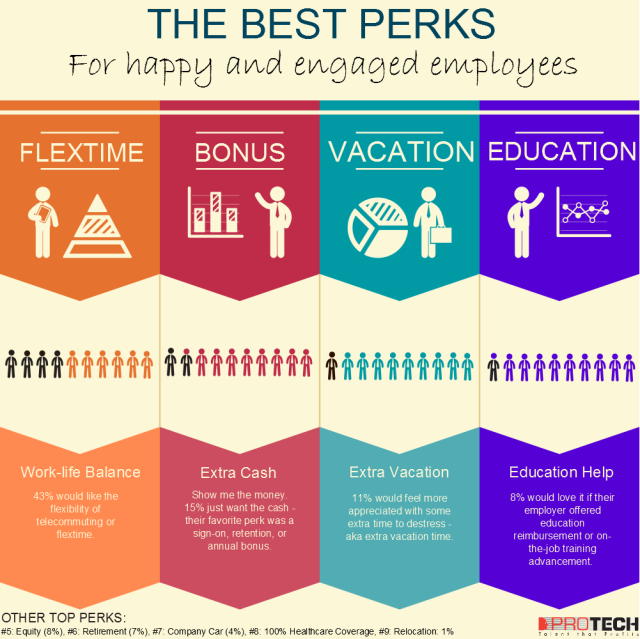Ping pong tables, catered lunches, refrigerators full of free Red Bull.
If you’re like most people, this is what you picture when you think of life in the tech industry: the perks. The free stuff is supposed to make your day more seamless. You don’t think of the innovative things tech workers build; you think of the things they’re given.
For those of us who lead tech companies, it’s tempting to reject this reputation as a caricature. The truth, however, is that we endorse it, whether we mean to or not. The general public defines tech culture based on those free perks because of the outsized importance we ourselves give them.
But there’s more to it than that. Our perk glorification has repercussions that extend beyond just the way we’re portrayed in popular culture.
Our misunderstanding of what matters to the people we hire cripples our ability to retain them.
And this is highly damaging. It’s one reason why, for example, so much of the tech industry is plagued by employee turnover. (The tech industry actually faces higher turnover than any other industry.)


What if, as opposed to a solution, the perks we give employees are really the problem?
This is something we at Honey began asking ourselves a few years ago. We were scaling fast at the time. And we wanted to improve our ability to attract and keep great talent. Knowing what other companies offered, we sat back and wondered: what can we do to make working at Honey truly rewarding? What do employees actually want and need?
The answer, in retrospect, seems obvious:
Above all, people want to feel invested in.
More than free beer, yoga, or laser tag, what most talented, ambitious people want is the tangible opportunity to become better, to do more, and to grow in their career and expertise.
For tech companies, that means the best “perk” you can provide is a meaningful investment––giving employees the opportunity and support to achieve something they didn’t originally think they could.
When, at Honey, we began making internal adjustments to provide employees with these kinds of opportunities, the difference was immediate. Offering a more systematic commitment to employee development predictably led to increased retention and higher employee satisfaction.
But it had another equally critical effect: it increased our company’s overall performance and effectiveness. And that’s another reason why investing in your people is the best “perk” you can give––it gives back.
By investing in employee growth, you’re also investing in the success and future of your company.
It’s no secret why. The more inspired your people, the more effective they are. And the more effective your people are, the more effective your company is.
Plus, the more satisfied your employees are, the longer they’ll stay with your company. As we all know, hiring great new talent is expensive, but so is losing it.
I think most leaders agree that investing in your people is important. So the question from here then becomes how, exactly, to do that?
Here’s what is currently working for us (because we’ll need to continue to adapt and change).
1) Make serious internal procedural adjustments aimed not only at inspiring your employees but also at challenging them.
That’s what we started with. We tweaked our annual review process to be forward-looking. We asked employees to list personal objectives for the year to come, and then we collaborated during their review to determine how we could accomplish those objectives together.
But there was also an important catch. We asked that employees’ objectives be things that truly scared them.
The objectives that we ended up working with employees to accomplish focused tangibly on giving them opportunities to do things like run meetings, mentor, or lead a key project––opportunities that would lead to other more influential opportunities in the future.
For example, engineers were tasked with building a system that could scale to tens of millions of users. On the marketing side, we asked folks who came on board with only small-budget experience to manage a budget of more than a million dollars. From there, roadmaps were set, internal management and leadership support was provided, and classes and professional development opportunities were paid for.
2) Lead by example.
Next, we had folks on our leadership team set ambitious, scary goals for ourselves.
Our CEO, for example, wasn’t very comfortable with public speaking. But he decided he’d face that challenge to help both himself and the company grow just as we were asking our employees to do, and he spoke openly about it in front of the entire company at an event.


This, we thought, would be key to ensuring we were adjusting not just our processes to facilitate holistic employee growth, but our culture, too.
Make work worth working for
To that end, we made it clear employees wouldn’t be graded on their ability to accomplish their ambitious, scary goal. In fact, we put up cultural safeguards to make sure employees felt safe failing or making mistakes because failure is inevitable and even beneficial when you’re building something new for the first time. “Make unique mistakes” is one of our mantras.
And the truth is, everything truly worth working for is a bit scary––sometimes even seemingly impossible––and no one can ever actually achieve or accomplish that thing without giving it a shot. And that, ultimately, was the aim of this “perk.” We want to help people get into a position where they could take their shot.
Investing in employee growth ultimately benefits you both.
What investing in your employees truly amounts to is respecting them as ambitious, capable adults. And the end result, if you commit to investing in your employees so systematically, is that your employees feel like part-owners in the company (because they are). They feel tangibly invested in the company’s success.
That, as far as I can tell, is the best perk you can give your people: a sense of purpose, inspiration, freedom, and worth.
We’d take that over a ping pong table any day.
Glen Alison is the Chief Operating Officer at Honey, where his main responsibility over the last 3 years has been to scale the company rapidly and efficiently while focusing on a culture of excellence. Prior to Honey, Glen co-founded and raised $3M for the social media app, Convoz, alongside Grammy award-winning musician Chamillionaire. He was previously at Twitter heading up their enterprise relationships for the data business, Gnip, where Glen was working prior to its acquisition by Twitter. In the last 20+ years, Glen has shipped software at Microsoft, Palm, Good Technology, Sprint, and America Online. He received his MS from George Washington University.







